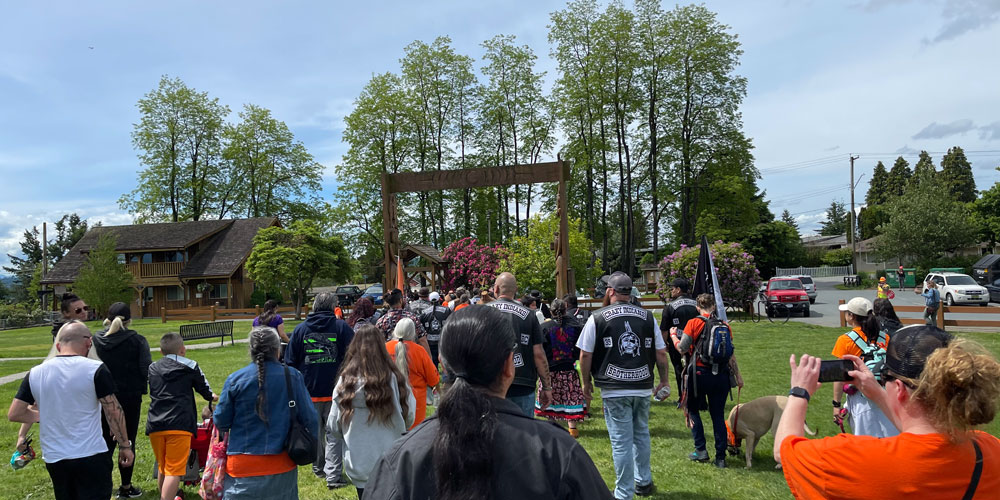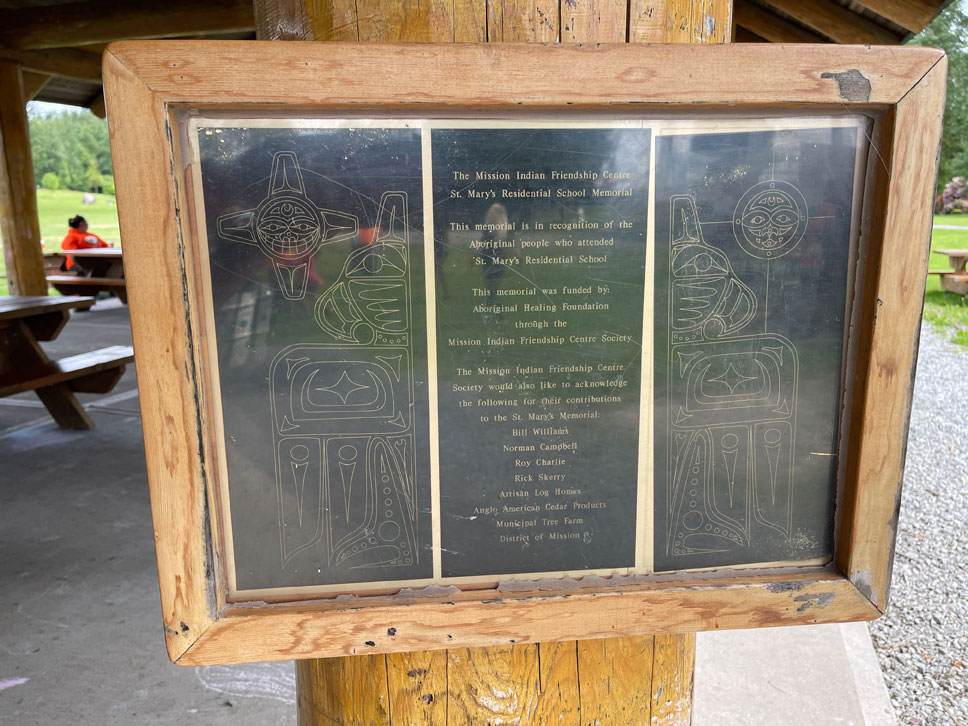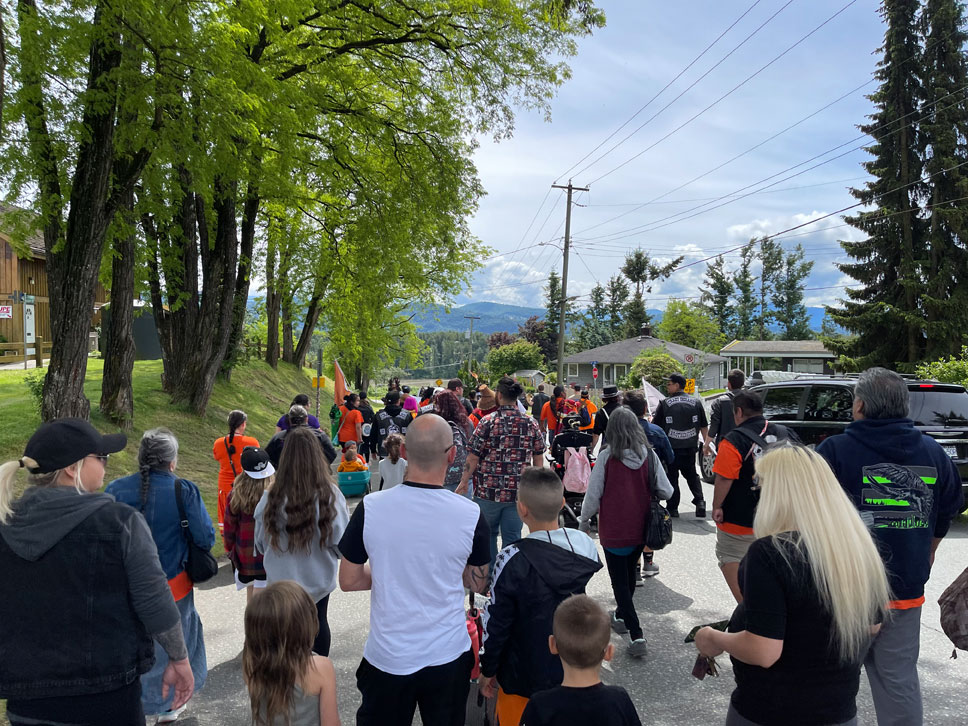
The article presented here may trigger unpleasant feelings or thoughts of past abuse. Please contact the 24-hour Residential Schools Crisis Line at 1-866-925-4419 if you require emotional support.
Thanks to his recent “The year of the graves” feature in the National Post, Terry Glavin has become the face of residential-school denialism for many on both sides of the issue. This is unequivocally wrong — Glavin is not a denier of the crimes of residential schools. However, it would also be wrong to read his article as the clear-headed myth-busting it is purported to be. It contains several major gaps that leave readers with the impression that the confirmation of unmarked graves at Kamloops, Cowessess, and elsewhere was a myth. Glavin has let it be known that this wasn’t his intention, though his actual intention might be hard to discern due to the particular decisions he made about which facts to include in, and which to omit from, his piece.
For this week’s episode, CANADALAND host Jesse Brown interviewed Glavin to discuss the article. The interview did not go well.
On his Substack, Glavin responded to the experience of the interview, writing: “So I don’t know what the result will be, but what I can tell you is that 25 minutes into the encounter I’m still asking him, over and over: what did I get wrong?”
1) Glavin writes about the findings at Cowessess First Nation, and quotes Chief Cadmus Delorme saying, “This is a Roman Catholic grave site. It’s not a residential school grave site.”
The quote is correct, but the impression it leaves the reader with is that reporting on Cowessess as a graveyard filled with residential-school children is wrong. However, in the same CBC article Glavin quotes from, Chief Delorme also says that although he can’t yet confirm it himself, oral history suggests that up to 75 per cent of those interred at the cemetery are believed to be children who attended Marieval Residential School. In other words, the site isn’t exclusively a residential-school gravesite, but a gravesite which is located on the grounds of a former residential school, and which, among other people, includes many residential-school children.
This mixed use for residential-school graveyards isn’t uncommon. This past weekend, I visited the residential-school graveyard at St. Mary’s in BC’s Fraser Valley — a school Glavin wrote about in the book Amongst God’s Own, and the school my family was sent to. There were graves of priests (at least one of whom was convicted of raping a residential-school student, later overturned on a technicality), nuns, and children — both from the community, and from the residential school itself. In Amongst God’s Own, Glavin describes the area: “Even the remnants of St. Mary’s Indian Residential School are gone. There is only a covered picnic area, the stone foundations of long-gone buildings, and a cemetery.”
Here he seems to draw a connection between the cemetery and the school, so why does he not do that for Cowessess?
Glavin says in his Substack expansion of his article that “in fact [it] wasn’t even a residential-school grave site at Cowessess.”
The supposed error of fact, on which Glavin’s story rests, is the difference between calling something a “residential-school gravesite” versus calling it a gravesite at a residential school, with residential-school children in it. If that sounds convoluted, it is — it is a vanishingly small line that distinguishes the two.
In September 2021, the Cowessess First Nation announced that it had identified 300 of the 751 unmarked graves. And in a press release from January of this year [pdf], the Cowessess Nation confirmed that “the 751 unmarked graves have been identified as both former children who attended the Residential School and locals, both First Nation and non-First Nations. The research team has been active in identifying every child, Roman Catholic Church official (fathers, sisters, administration), and specialists. Once we do our chronological research, we will be able to share the true story by identifying which children did not make it home.”

2) Glavin discusses the Shubenacadie Residential School in Nova Scotia, concluding with: “At Shubenacadie, where extensive investigations turned up nothing, Crown-Indigenous Relations Minister Marc Miller announced a fund of $326,700 for the Sipekne’katik community to conduct further research and memorialize the residential school with commemorative events and a plaque.”
The impression this might leave the reader with is that, in spite of a failure to find graves, the Sipekne’katik First Nation was sent money for a memorial. However, both the CBC story that Glavin’s piece linked to and the government press release announcing the funding explained that the “further research” would involve “fieldwork” on land left out of the initial survey. In other words, the search is not yet complete.
3) Elsewhere in the article, Glavin writes that “the Tk’emlúps community has not announced a decision to undertake any excavations.”
In a May 20th Canadian Press story that ran on CBC.ca with the headline “Work to exhume remains at former Kamloops residential school could begin soon,” Tk’emlúps Chief Rosanne Casimir explained that the process of managing the graves would continue, from “exhumation to memorialization” — this is something she has said before in other interviews, and has made clear at press conferences surrounding the issue. The First Nation has already put together a team of archaeologists, among others, to plan the excavations.
In his interview with CANADALAND, Glavin said that he didn’t have space to mention that the First Nation was undertaking a process that would lead to excavations. Many commentators have spun the fact that excavations have not yet begun as proof that the First Nation is afraid of having its story proven false — so this omission is particularly harmful.
Seven hundred and fifty-one graves were individually located at the site of the Marieval Residential School on the Cowessess First Nation. The Sipekne’katik First Nation has received funds to complete its survey of the grounds of the Shubenacadie Residential School. The Tk’emlúps First Nation continues work to prepare for excavations of the unmarked graves at the Kamloops Residential School. And work is ongoing at the sites of 70 more residential schools. With some small exceptions which were corrected contemporaneously, the understanding of what happened with the confirmation of graves at residential-school sites is largely correct.
Even the early error in describing these as “mass graves,” instead of “unmarked” graves, has since been mooted by recent findings at the Saddle Lake Cree Nation in Alberta. On May 17th of this year, Saddle Lake council member Jason Whiskeyjack confirmed that his nation has been finding the unmarked graves of children since 2004, including what he described as a “mass grave” which “had numerous children-sized skeletons wrapped in white cloth.”
Terry Glavin is no stranger to First Nations life. Besides writing a book on St. Mary’s, Glavin was a fixture in First Nations circles in the 80s and 90s — and one of the few people who would report sympathetically about our communities. He was around the Katzie reserve when I lived there as a teenager. He’d order burgers from my mom’s shop, he worked at the band office with my cousin. He wrote the inquest report on another cousin’s death, and his wife and I even share a common ancestor on our Hawaiian side. There was a time when you could say that he was a part of First Nations life and society — an argument that I have made in print before.
In his article and in his interview with CANADALAND, Glavin seems to be speaking in a role of self-appointed interlocutor between First Nations and the press. The hype, in his telling, is solely a white phenomenon, while Indigenous leaders are more careful in their public statements on this subject. And that is another major error.
Yes, these sites aren’t in themselves a discovery — they are documented, and have long been known as graveyards by First Nations people. However, the locations of specific graves and the numbers are news, because in many cases the specifics were not known before, and they have confirmed Indigenous oral histories of these places. This has had an enormous impact for First Nations people.
The reaction that has followed these findings isn’t wrong. There are numbers and then there are graves. And graves of children, too. And in numbers which suggest that Truth and Reconciliation Commission (TRC) chair Murray Sinclair’s higher-range estimate of the numbers of children who died there may be correct. Sinclair said there may be as many as 25,000 dead.
Speaking shortly after the confirmation of graves at Kamloops Residential School, Tk’emlúps chief Casimir said, “It’s a harsh reality, it’s something that we’ve always had to fight to prove.”
“Some drivers shouted racial slurs, some threats. A man in a blue pickup truck accelerated into the crowd, injuring four people. The incident took place a few centimetres behind me.”
For First Nations people, this is what Kamloops was about. It was confirmation of what people have been saying for decades. These confirmations make an abstract horror specific and tangible. And that tangibility is what Glavin undermines in his piece. Because if you put that into question, the mostly empathetic reaction we have seen from regular Canadians goes with it.
Glavin’s article comes from a worldview that rejects the simplistic reduction of Canada’s history with First Nations to a relationship between an abuser and a victim. That false dichotomy is a lot of what you see on social media, and it’s not reality. There was give and take, and Native people had much more agency than is suggested by the popular portrayal in the press.
The dominant abuser-victim narrative can cause some to give credence to wild fantasies about things that happened at the residential schools. This was exemplified by the attention heaped on the defrocked United Church minister and residential-school fabulist Kevin Annett since the news from Kamloops came out. In 2008, Glavin wrote a powerful article about Annett’s excesses. Suffice it to say that Annett’s stories have no foundation in the real world, and shouldn’t be shared by anyone.
But Glavin puts the recent findings at residential schools in the same box as he puts Annett’s fantasies. This is presumably out of concern that, as he said back in 2008, “If the Truth and Reconciliation Commission gets dragged into the strange, alternative reality … the commission’s purpose could be easily defeated. If that happens, we will have lost an historic opportunity to see justice properly done in finally turning the page on one of the darkest and most disgraceful chapters in Canadian history.”
In his interview with CANADALAND, Glavin says that the numbers which are known don’t suggest that residential schools are where the graves should be found. If people are finding graves there now, it must be due to some Annett-inspired gullibility and ignorance.
Glavin arrives at this conclusion based on the errors and omissions I have noted above, and it is not one supported by the evidence, or by the conclusions drawn by TRC chair Murray Sinclair — whom Glavin has said that he agrees with:
“When I was asked to chair the Truth and Reconciliation Commission, I thought that I had a pretty good idea of what to expect.…But the one aspect of residential schools that really proved to be quite shocking, to me personally, was the stories that we began to gather of the children who died in the schools. Of the children who died, sometimes deliberately, at the hands of others who were there, and in such large numbers. Survivors talked about, during the time that they were there, about children who suddenly went missing.…Now we’re beginning to see evidence of the numbers of children who died. We know that there were probably lots of sites similar to Kamloops that are going to come to light in the future. And we need to begin to prepare ourselves for that.”
In other words, according to Sinclair, these residential-school sites are exactly where we should expect to find these graves, and many more to come.
The findings of the TRC are, in part, incomplete — and that’s because the federal government refused to authorize funding to complete the work of documenting all of the deaths. The TRC gave a preliminary death toll but said that this would rise.
In the follow-up article on his Substack, Glavin concludes that “almost all the shock-horror stories that followed were just as wrong, on their own merits, as the first one about the ‘mass grave’ in Kamloops.”
These are real graves, real findings in 2022, and they should be shocking and horrific — as they are even to those, like Murray Sinclair, who have spent years working on bringing the truth of the residential schools to light. News coverage of Kamloops, Cowessess, and elsewhere was largely correct, and shouldn’t be ignored based on a handful of incidents of faulty — or even just early and incomplete — reporting.
Throughout the recent controversy around Glavin’s piece and others, a lot of non-Native people have said they were speaking for us as Indigenous peoples, or preventing the white media from speaking over us. And I can see why some older people might think that is necessary, as there were so few Indigenous people in the 80s and 90s who were in a position where we were allowed to speak for ourselves in the press. Times have changed, at least in that respect, though the hate these people helped us fight against back then remains, albeit greatly diminished.
This past weekend, a group called the “Crazy Indians Brotherhood” organized a march to St. Mary’s Residential School. The march was unrelated to any of the current media controversies, but was an annual memorial event.

I joined the group of about 50–100 as we marched from the site of the original residential school and cemetery to the grounds of the rebuilt residential school. It’s the latter that the survivors who joined us attended when they were children.
We marched along the roadway a few hundred meters to the entrance to the site, which is held as a jointly-owned reserve by several different First Nations. As we began to enter the site, some drivers shouted racial slurs, some threats. A man in a blue pickup truck accelerated into the crowd, injuring four people. The incident took place a few centimetres behind me, and when I turned to see the aftermath, I saw the man in the truck sticking his head out of his window and shouting something indistinct at us before fleeing the scene.
The local RCMP were given his license plate number, but apparently before even tracking him down and speaking with him, they said that he had merely been “impatient” and that there was “no indication” that the incident was motivated by hate.
However, the meaning of a First Nations crowd wearing orange, waving an “Every Child Matters” flag, and marching between two residential-school sites, while singing and drumming, isn’t ambiguous. Many trains, trucks, and cars honked horns in support of us as they passed — who we are was apparent to them. I find it hard to believe that anyone didn’t understand what they were doing when they drove into four people.
There are many different sources of the hatred that some feel for First Nations people. A lot of it is rooted in shame for what happened at the residential schools, and shame leads people to deny facts and history. Standing at the foot of a residential school while our people are physically attacked — you can see the effects of what denial of the graves has on society. Unlike the Mission RCMP, I’m not a psychic, and can’t read the driver’s mind. But the combination of factors is suggestive.
Once things calmed down, we continued up to the residential school, where ceremony was done, speeches were made, and people sat down to eat together.
As they ate, I spoke to attendees about what last year’s findings meant to them, and how they felt about denialism of the kind that seems to have gained momentum since Glavin published his National Post article.
Rather than spend any more time quoting non-Natives on this issue, I will leave the last words on this subject to them. If people seem unduly emotional or raw, remember the subject matter, and that someone had just moments before tried to run down four of us who were trying to bring attention to the children who lived and died where we were standing:
Photos and videos by Robert Jago.
Correction (June 14, 2022, at 1:10 p.m. EDT): This piece originally described Kevin Annett as a former Anglican minister. He is in fact a former United Church minister.